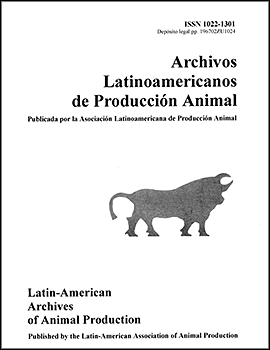
|
Archivos Latinoamericanos de Produccion Animal
Asociacion Latinoamericana de Produccion Animal
ISSN: 1022-1301
EISSN: 1022-1301
Vol. 12, No. 4s1, 2004, pp. 1-6
|
 Bioline Code: la04017
Bioline Code: la04017
Full paper language: Spanish
Document type: Research Article
Document available free of charge
|
|
|
Archivos Latinoamericanos de Produccion Animal, Vol. 12, No. 4s1, 2004, pp. 1-6
| es |
Caracterización del recurso genético de la cabra criolla y su rol socio-económico en Cochabamba, Bolivia
A. Stemmer, T. Altug, A. Valle Zàrate y R. Ergueta
Resumen
El presente trabajo està basado en datos registrados desde enero 1999 hasta marzo 2000 en la Provincia Mizque del Departamento de Cochabamba en Bolivia. Según características se tomaron en cuenta hasta 1078 cabras Criollas en 16 fincas. El entorno socio-económico se investigó mediante observaciones participativas, conversaciones en grupo, entrevistas informales y estructuradas en 42 hogares de capricultores. Las cabras Criollas tuvieron partos durante todo el año con mayor número en los meses de junio y marzo. El peso promedio al parto fue 26,9 kg, el número de cabritos por parto fue de 1,2 y la mortalidad de las crías hasta los 3 meses de edad 11,2 %. Peso al nacer y a los 120 días de edad fue 2,2 kg y 9,2 kg, respectivamente. Durante la época seca, la producción de leche fue 235 g/día en promedio y durante la época de lluvia 444 ml/día. La mayoría de las fincas (16 de 42) cultivan 1 a 2 ha con papa, maíz y otros cultivos. La cría de animales es una parte integral de la producción de la finca. Se crían varias especies animales; siendo las màs numerosas caprinos y ovinos. Las familias encuestadas manifestaron que las razones principales para la cría de cabras son la producción de estiércol, leche y carne, ademàs del rol tradicional en la cultura de estos pobladores. La mujer es la encargada principal de la cría de cabras. Los problemas principales se nombraron como la escasez de forraje, enfermedades y depredadores.
Palabras-clave
Cabras, Caracterización, Rol socio-económico, Bolivia
|
| |
| en |
Characterization of the genetic resource of Criollo goats and their socio-economic role in Cochabamba, Bolivia.
A. Stemmer, T. Altug, A. Valle Zàrate y R. Ergueta
Abstract
The present study is based on data registered between January 1999 and March 2000 in the province of Mizque, Cochabamba department, Bolivia. A series of traits were studied in a total of 1078 Criollo goats on 16 farms. The socio-economical setting was investigated applying participant observation, group conversations, and informal as well as structured interviews in 46 households of goat keepers. Criollo goats gave birth throughout the year with peaks in June and March. Average weight at parturition was 26.9 kg, number of kids per litter was 1.2, and mortality rate of kids up to 3 months old was 11.2 %. Weights at birth and at 120 days of age were 2.2 and 9.2 kg, respectively. During the dry and rainy seasons, milk production amounted to 235 g/d and 444 ml/d on average, respectively. The majority of farms (16 out of 42) cultivated 1 to 2 ha with potato, maize, and other crops. Animal husbandry formed an integral part of the farming systems. Various species of animals were kept with goats and sheep being the most numerous. The interviewed families stated that the main reasons for keeping goats were the production of dung, milk and meat as well as the traditional functions of goats in their culture. The main problems indicated were: shortage of forrage; diseases; and predators.
Keywords
Goats, Characterization, Social-economic role, Bolivia
|
| |
© Copyright 2004 - ALPA. Arch. Latinoam. Prod. Anim.
Alternative site location: http://www.alpa.org.ve/ojs/index.php
|
|
